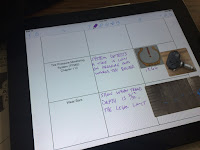Using Discussion Boards to Give All Students a Voice
As teachers, we are always looking for more ways to engage our students and for them to have a voice in our classrooms. There are methods like a fishbowl, Socratic Seminar, and roundtable discussions, to name a few In his AP US History classes, Mr. Elliott Olson has used document-based roundtable discussions as a way for his students to demonstrate their learning from various texts, practice their questioning skills, and as a means to provide all students with a voice.
So what does this look like?
As you can see, the teacher and half of the class form an inner circle while the remaining students form an outer circle. The students sitting in the inner circle are the students who speak and share their opinions, questions, evidence, etc.
In a “tech free” discussion, the students in the outer circle are waiting for their turn while jotting down notes for when the circles swap and it is their turn to speak. When it’s time, the students swap seats and the discussion continues with new perspectives. The objective is that all students are able to speak, and speak more often, given the smaller group.
While Mr. Olson has found success with this method in the past, he looked to our 1:1 environment to find a way to increase engagement of the students in the outer circle. This year, instead of having the students in the outer circle jot down notes on paper, he asked them to log into TodaysMeet.com and post their comments and ideas for each other to see. After using it for one lesson, Mr. Olson really liked the idea that the students were still participating in the discussion, even in the outer circle, but didn’t feel that Today’s Meet didn’t exactly meet the needs of the students for this activity.
For the next roundtable, he created a discussion within Schoology for the students to use and was very pleased with the results. As you can see in the above images, Mr. Olson was able to post the questions to the outer circle students at the same time as the inner circle students. He listened to the inner circle students discuss and the students in the outer circle have their own virtual discussion through Schoology either commenting on what their peers in the inner circle are saying or starting new ideas. By doing this, Mr. Olson has found a way to have a whole class discussion without all of the waiting and/or commotion that would be created by 30 students trying to speak at the same time. This keeps the entire class engaged simultaneously. It also creates a digital archive of the online discussion that can be helpful for students who would like to review the material or weren’t able to be in class for the discussion.
- have students hypothesize with something from your curriculum-What would it look like if the Cuban Missile Crisis hadn’t been resolved? How would the story change if that protagonist’s parents hadn’t died at a young age?
- post a vocabulary word and ask students to enhance it with definitions, examples in context, with images, etc.
- create a board for students to ask each other questions about assignments, etc. have students find articles on
- the current topic, write a discussion question, and then comment on other students’ questions (source +Sara Kahle Ruiz)
Have you used discussion boards in your classroom? Share your ideas in the comments section. Need some more support? Talk to +Dawn Bodden or one of your DTCs!






Comments
Post a Comment